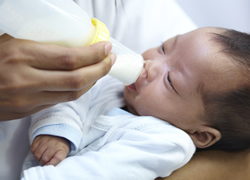Feeding a Child with a Cleft Lip or Cleft Palate
 Babies born with cleft lip and palate, like any other babies, need to learn how to feed successfully in order to thrive and grow. If the baby has a cleft lip only (with a normal palate), he/she should be able to eat normally using standard techniques. Babies with cleft lip only can even breastfeed, if you desire.
Babies born with cleft lip and palate, like any other babies, need to learn how to feed successfully in order to thrive and grow. If the baby has a cleft lip only (with a normal palate), he/she should be able to eat normally using standard techniques. Babies with cleft lip only can even breastfeed, if you desire.
However, babies born with a cleft lip and palate, or cleft palate only, have an opening in the roof of their mouth- between the mouth and nose. This opening in the palate makes it difficult to create the suction needed to pull milk out of the bottle or to latch on to the breast to breastfeed. This means that babies with cleft palate are at risk for poor weight gain because they use a lot of energy to feed.
Our job is to work with parents and teach them how to feed their baby with a specialized cleft bottle and nipple. Our nurse practitioner, Melisande Ploutz, will see you and your baby weekly until your child is eating well and gaining weight appropriately. Babies should be able to feed comfortably within a reasonable amount of time, without struggling to breathe, choking, or working very hard to get the milk out of the bottle. The feeding goal is to help the baby get the right amount of milk in the right amount of time, and to avoid taking in too much air. Here are some simple guidelines:
- Use a specialized cleft palate bottle as demonstrated by your baby’s medical team.
- Place your baby in an upright, sitting position to prevent the formula from flowing back into the nose area.
- Keep the bottle tilted so the nipple is always filled with milk and pointed down away from the cleft. Your baby will move the nipple into the most comfortable position for him/her.
- As your baby feeds, some milk may escape through the nose. This is very common and expected, and it does not mean the baby is choking. Hold your baby in a more upright position as this will lessen the amount of milk coming through the nose.
- Babies with a cleft need to be burped more often because they take in more air while feeding. Watch for signs of discomfort; your baby will give you signs when it’s time to stop and burp.
How will you know it’s working? Your baby should feed in about 30 minutes or less. Longer feedings can cause exhaustion and burn up too many calories that the baby needs to gain weight.
Secondly, your baby should return to birth weight by about 2 weeks of age and gain between a half an ounce to one ounce per day. This is an average, so be sure to follow the guidelines of your medical team.
Please click here for more information about feeding your baby with a cleft.
Bottle Manufacturers
All of these bottles are available for you at our clinic. Call (585) 275-1979.